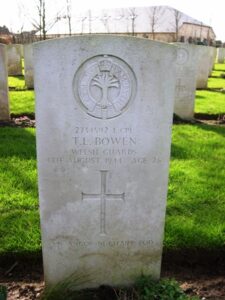Llanllwni is a small village, sat in the rural heart of Carmarthenshire along the A485 from Carmarthen to Lampeter. The village church is dedicated to St. Luke, and inside are two separate marble memorials, one to the parishioners who fell during WW1, and the other to those who fell during WW2. The photographs of the memorials are courtesy of Peter Hector-Jones.
The Great War, 1914-1918
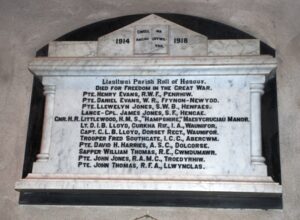
Daniel Evans, Private, 202981, Welsh Regiment. Daniel was born at Llanllwni, the son of Thomas Evans (a shoemaker) and Sarah Evans (nee Jones), of Ffynon Newydd. Daniel worked as a Carter on a local farm prior to the war, and enlisted at Carmarthen into the Welsh Regiment, serving with the 18th (Bantam) Battalion, as part of 119 Brigade, 40th Division. The Division proceeded to France during June 1916, serving firstly at Loos, before being brought into the latter stages of the Battle of the Somme, fighting at the Ancre. After the German retreat to the Hindenburg Line in early 1917, the Division played a major part in the Battle of Cambrai in late 1917, which is where Daniel was Killed in Action on 23 November 1917, aged 36. He is remembered on the Cambrai Memorial, Louverval, France. A letter sent to Daniels’ sister by a friend of his stated that Daniel was shot in the head by a sniper when moving to another trench.
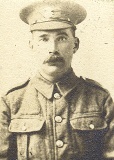
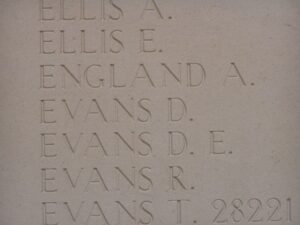
Henry Evans, Private, 55453, Royal Welsh Fusiliers. Henry was the son of Evan and Mary Evans, of Penrhiw, Llanllwni. Henry originally enlisted at Llandovery into the Pembroke Yeomanry, but was posted to France, where he joined the 16th Battalion, Royal Welsh Fusiliers, attached to 113 Brigade, 38th (Welsh) Division. Henry was probably one of a large number of reinforcements who joined the battalion at Boesinghe around August 1916 after the battering the Welsh had taken during the capture of Mametz Wood in July. Henry was acting as a stretcher bearer when he was killed by shrapnel during the assault on Pilckem Ridge on 31 July 1917, aged 24. He is buried at Artillery Wood Cemetery, Belgium. Some time after the Armistice, his family placed a heart shaped marble plaque at the foot of Henry’s grave, which still sits in place today, and is enscribed; ‘Melys, Y Cof Am Danat Ym Henraiw Llanllwni’.
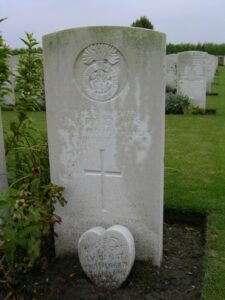
David Harry Harries, Private, 7881, Kings Own Liverpool Regiment. David was the son of David and Elizabeth Harries, of Dolgorse, Llanllwni, and the husband of Mary Anne Harries (nee Davies), of The Bungalow, Alltyblaca, Llanybydder. Very little is presently known of his military service, but he enlisted into the army in March 1917, and went to France with a Labour Company of the King’s Liverpool Regiment. David became ill in France, and was sent home, suffering from trench fever. He had married Mary just prior to dying on 28 November 1918, aged 29, and is buried in Llanllwni Congregational Chapelyard.
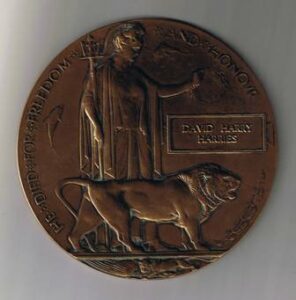
James Jones, Lance Corporal, 70342, Notts & Derby (Sherwood Foresters). James was the son of Thomas and Sarah Jones, of Hengae, Llanllwni. He enlisted at Warley, Essex into the Leicester Regiment, but later transferred into the 2nd Battalion, Sherwood Foresters. The Battalion were attached to 18 Brigade, 6th Division at the start of the war, and had landed in France on 10 September 1914. They had been rushed to support the weakened BEF on the Aisne, and fought in the Battle there before being posted to positions east of Ypres. Here they took part in the Actions of Hooge, when the British blew the massive mine under the German Lines, creating the famous Hooge Crater. On 27 October 1915 the Battalion were moved to 71 Brigade, but remained with the 6th Division, fighting with them during the 1916 Somme Offensive, at the Battles of Flers-Courcelette, Morval and Le Transloy, and they moved to Loos in early 1917, where they fought at Hill 70. James was killed in action at Loos on 1 July 1917. He was 34 years old, and is remembered on the Loos Memorial, France.
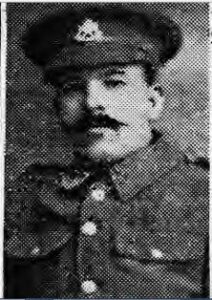
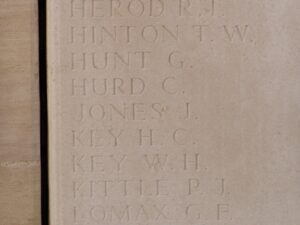
John Jones, Private, 7815, Royal Scots Fusiliers. John was born in Llanwenog in 1895, the son of Samuel and Margaret Jones. The family had moved to Llanllwni prior to 1901, and John worked as a farm labourer, prior to enlisting into the army. He served in the 1st Battalion, Royal Scots Fusiliers, part of 9 Brigade, 3rd Division. The Division was one of the first in France, fighting from the start of the war at the Battle of Mons, and they put up a gallant rearguard action whilst retreating south toward the Aisne, where the German Offensive was halted. They were moved north as the fighting begun to stagnate into the trench warfare that was to mark the war, and took part in the Battle of La Bassee, and First Ypres, where the Ancient City was saved from German occupation. After wintering at Ypres, and taking part in the now famous Christmas Truce of 1914, John was Killed in Action on 12 March 1915, aged 19. He is commemorated on the Ypres (Menin Gate) Memorial, Belgium. (The memorial states R.A.M.C., but this looks to be the correct man.)

John Jones, Private, TR/4/12333, Welsh Regiment. John was born in 1888, the son of Mary Jones, of Cartref, New Inn, Pencader. He enlisted on 9 December 1915 at Newcastle Emlyn into the 20th Battalion, Welsh Regiment, part of the 13th Reserve Brigade. The Battalion became part of the Training Reserve in 1916, severing its ties with the Welsh. John became ill while training, and died of tuberculosis at Kinmel Park on 27 February 1917, aged 28, without having seen overseas service. He is buried at Llanllwni (St. Luke) Churchyard.
Llewellyn Jones, Private, 39592, South Wales Borderers. Llewellyn was the son of David and Catherine Jones, of Henfaes, Llanybydder. Llewellyn enlisted at Carmarthen into the Pembroke Yeomanry, and was posted to France, where he joined the 2nd Battalion, South Wales Borderers. The battalion had the distinction of having fought at Tientsin, China at the outbreak of war, and took part in the Gallipoli landings of 25 April 1915, attached to 87 Brigade, 29th Division. The Division were on the Somme in 1916, taking part in the Battle of Le Transloy, when Llewellyn was killed in action on 21 October 1916, aged 22. He is remembered on the Thiepval Memorial to the missing. Llewellyn is also listed on the Llanybydder Memorial.
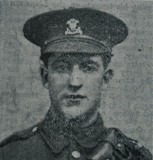
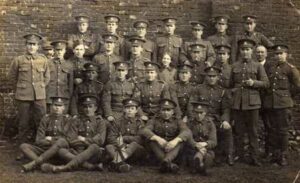
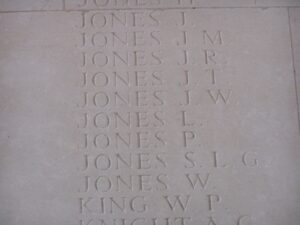
Hariph Reginald Littlewood, Able Seaman, 215102, Royal Navy. Hariph was born at Kensington, London on 30 November 1885, the son of Frederick and Mazel Littlewood. He married Violet Adelaide Pauline Recher in October 1909, and the couple had a son the following year. Hariph had worked as a chauffeur/ mechanic at Maesycrugiau Manor, Llanllwni prior to the war, after having already served with the Royal Navy. At the outbreak of war, Hariph rejoined the colours, and was posted aboard the Armoured Cruiser HMS Hampshire. Hampshire fought during the Battle of Jutland on 31 May 1916. Immediately after the battle, she was ordered to Scapa Flow, to take Lord Kitchener on a diplomatic mission to Russia. Setting course for Archangel on 5 June 1916, she struck a mine off the Orkneys, sinking with the loss of all hands bar twelve. One of the unfortunate casualties, as well as Kitchener and his staff, was Hariph. He was 30 years old, and remembered on the Portsmouth Naval Memorial, Hampshire.
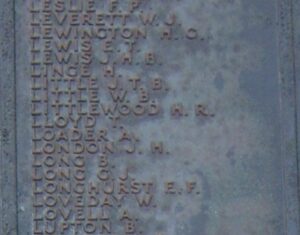
Duncan Ian Bowen Lloyd, Lieutenant, 5th Gurkha Rifles. Duncan was born on 16 March 1886, the Son of Charles and Margaret MacFie Lloyd (nee Campbell), of Waunifor, Maesycrugiau. He was commissioned into the Indian Army, and served with the 1st Battalion, the 5th Gurkha Rifles. The Gurkha’s saw action at Gallipoli, losing over 120 men and officers within hours of landing on the Peninsula on 25 April 1915. After a brief spell of rebuilding at Mudros, they were sent again to Gallipoli during August 1915, and it was here that Duncan was Killed in Action, on 14 August 1915 aged 29. He had survived his brother Gwion (below) by just three days, and is remembered on the Helles Memorial, Gallipoli.
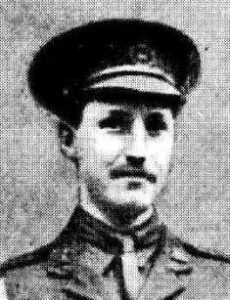
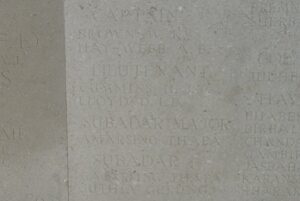
Gwion Llewellyn Bowen Lloyd, Captain, Dorsetshire Regiment. Gwion was born on 21 February 1888, the Son of Charles and Margaret MacFie Lloyd (nee Campbell), of Waunifor, Maesycrugiau. He served as a Captain in the 5th Battalion, Dorset Regiment, part of 34 Brigade, 11th Division. The division sailed from Liverpool on 1 July 1915 bound for the Mediterranean, and on 7 August 1915 landed at Suvla Bay, Gallipoli, just in time for some of the bloodiest fighting of the campaign. Gwion was Killed in Action just days after setting foot on Gallipoli, during the Battle of Sari Bair, on 11 August 1915. He was 27 years old, and is remembered on the Helles Memorial, Gallipoli.
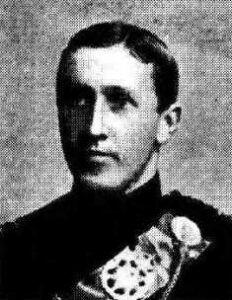
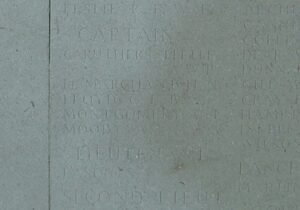
Frederick Southgate, Private, 320271, Welsh Regiment. Frederick was born at Ipswich in 1895. He worked as a farm labourer for Mr. James Davies, of Abercwm, Llanllwni. Fred enlisted at Carmarthen into the Pembroke Yeomanry, which assembled at Tenby in August 1914 as part of the South Wales Mounted Brigade, and in March 1916 moved to Egypt as part of the 1st Mounted Brigade, joining the Western Frontier Force. In January, 1917 the Yeomanry Brigades were reorganised, and the Pembroke Yeomanry merged with the Glamorgan Yeomanry to form the 24th Battalion, the Welsh Regiment, as part of 231 Brigade, 74th Division. The Division was gearing up for its move into Palestine, when Frederick was killed by a bomb dropped by a German aircraft on 21 April 1917, aged 21. He is buried at Gaza War Cemetery, Israel.
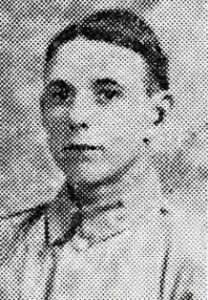
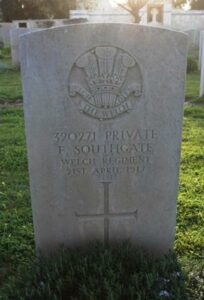
John Thomas, Royal Field Artillery. John is shown on the memorial as having lived at Llwynglas, Llanllwni. He cannot presently be identified, but a newspaper report of 29 November 1918 reported his death on 13 November 1918. He was probably the son of Benjamin and Elizabeth Thomas.
William Thomas, Sapper, WR/317268, Royal Engineers. William was born at Panteg Shop, Llanllwni, the Son of William and Mary Thomas and the Husband of Elizabeth Thomas, later of Cross Inn Fach, Llanfihangel-ar-arth. He was a Packer with the GWR at Swansea prior to joining the colours. William enlisted into the Royal Engineers. He had already been serving for two years when he joined the 263rd Railway Company, RE, which was raised at Longmoor and embarked to France on 26 April 1917. Once in France, William was assigned to a construction train, and his unit were deployed in laying new standard gauge track, often in very close proximity to the front. William took ill, and died in France of influenza on 19 November 1918, aged 25. He is buried at Awoingt British Cemetery, France.
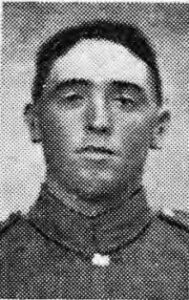
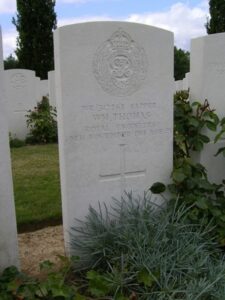
World War Two, 1939-1945
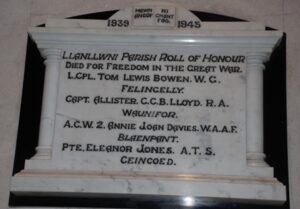
Tom Lewis Bowen, Lance Corporal, 2734592, Welsh Guards. Tom was the son of John and Mary Bowen, of Felingelli, Llanllwni. He served with the 1st Battalion, Welsh Guards, who were in France as part of the BEF in 1939. They fought during the epic withdrawal to Dunkirk, and the evacuation, and returned to France in June 1940 as part of the Allied forces which landed after D-Day, on 26 June 1944. The 1st Battalion landed in Normandy attached to the Guards Armoured Division, and fought through the Battle of Goodwood, where Caen was encircled and captured, into the Bocage. Tom was killed in action during the Battle of Normandy, on 4 August 1944. He was 26 years old, and is buried in Bayeux War Cemetery.
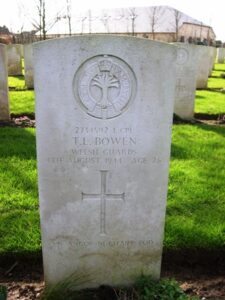
Ann Joan Davies, Aircraftwoman 1st Class, 2076919, Women’s Auxiliary Air Force. Ann was the daughter of Henry and Rosie Mary Davies, of Blaenpant, Llanllwni. Ann served as an Aircraftswoman with the Women’s Auxiliary Air Force, and died on active service at Bristol on 15 August 1942, aged just 19. Ann is buried at Rhydybont Congregational Chapelyard.
Eleanor Jones, Private, Auxiliary Territorial Service. Eleanor has proved difficult to identify, but this looks to be the correct woman. She was the daughter of Evan Morgan Jones and Elizabeth Jones, of Ceincoed, Llanllwni. The family had moved to 169, Brunswick Road, Poplar prior to the war. Eleanor served with the Auxiliary Territorial Service, and died at 18, Ashwell Road, Poplar during an air raid, probably a V1 rocket, on 10 July 1944, aged 19.
Alister Charles Bowen Cranstoun Lloyd, Captain, 124689, Royal Artillery. Alister was the son of Alister Campbell Bowen Lloyd and Mary Pitcairn Lloyd, of Swanage, Dorsetshire. He had studied for his M.A. before gaining a commission from the 121st Officer Cadet training Battalion into the Royal Artillery on 9 March 1940, and was posted to 101 Battery, 20 Anti-Tank Regiment, Royal Artillery. The unit was equipped with the M10 Tank Destroyer, known as The Wolverine, and landed in Normandy with the 3rd Division in June 1944. Alister was killed during the attempt to break out from the Normandy beach head on 11 June 1944. He was 27 years old, and is buried in Banneville-La-Campagne War Cemetery, France.
